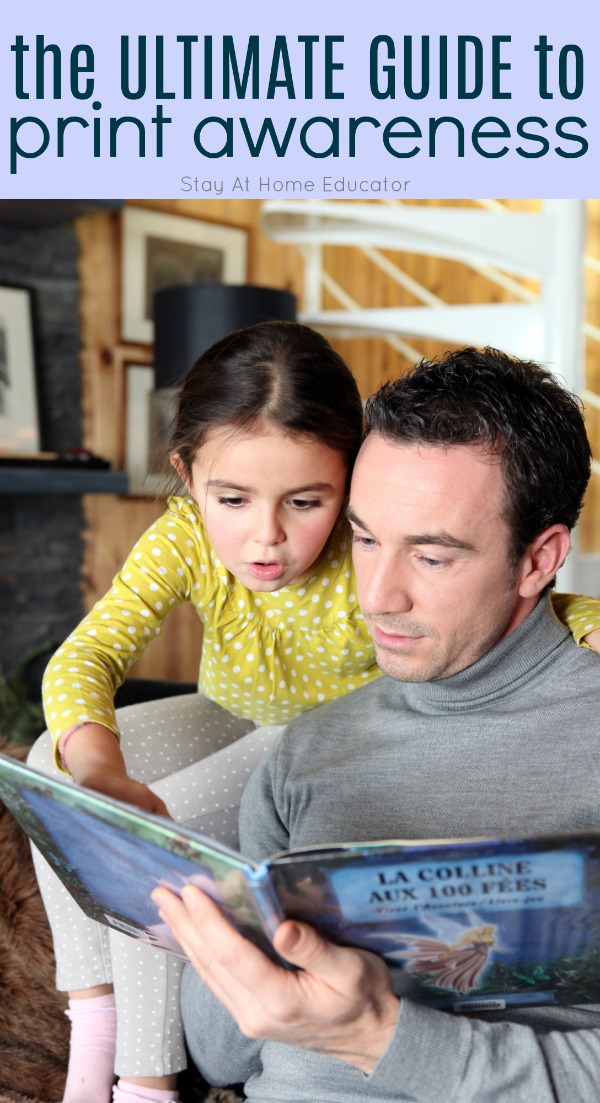Most children become aware of print long before the enter former schooling. Called print awareness, it is a child’s first introduction to literacy. This post is your ultimate resource to print awareness skills in preschool.
We’re going to cover what print awareness is, how children develop deep concepts of print skills, and what teachers can do when students are struggling.
What Preschool Teachers Need to Know About Print Awareness

Sure, print concepts can sound a bit mundane at first glance.
Or a bit obvious.
Concepts of print is one of those things you think children will naturally pick up on and so therefor doesn’t need to be taught. And that is the case for some children.
But not for all children.
But the truth is, these subtle aspects of emergent literacy actually building a strong foundation for learning to read, brick by brick – they form the building blocks that make it possible for us to effortlessly read from left-right and glide through text as if it were second – which is how reading should be!
But as obvious as they may be to grownups, according to Emily Rogers, Associate Professor at Ohio State University, an awareness of these concepts “is not information we’re born with. We have to learn them.” We have to discover “how print operates,” Rogers says.
So let’s a deep dive into how to assess concepts of print and how to teach children all about print awareness.
About the “Big Four” of Preschool Literacy Instruction
There are four major components in preschool literacy instruction that, when woven together in systematic and explicit literacy instruction, create successful future readers. These components have been identified by researchers and continue to be solidified as crucial to early literacy development.
The “Big Four” of preschool literacy instruction are as follows:
What is Print Awareness?
Print awareness refers to a child’s understanding that written language has a direct relationship with spoken language. Here is a little more about what is encompassed in print awareness:
- It is closely related to word awareness, the ability to recognize that spoken words have a written form.
- Print has multiple forms and uses.
- Print is a means of communication.
- Print is organized in a systematic and predictable way.
Other Terms for Print Awareness
To be effective in teaching preschool, it’s important to really understand print awareness and all that it entails.
The term “print awareness” is an umbrella term that encompasses the greater components of how print is organized for communication. Other terms hanging under the umbrella term that are related are:
- concepts of print
- print literacy
- print knowledge
Concepts of print is the most closely related to the formal print awareness term, but the other two terms are also sometimes used interchangeably.
More About Concepts of Print
Why is it Print Awareness Important for Preschoolers?
Children with strong print awareness skills understand that written language carries meaning, much like spoken language carries meaning. Such children also understand that the two are linked. They understand that print can be read and have the exact same meaning as when those words are spoken.
Children who struggle with print awareness skills are more likely to struggle with learning to read. Their performance on print awareness tasks are a reliable indicator of their future reading achievement.
Because of the way our world is structured, many children begin developing print awareness skills long before they enter school.

Kids who are print aware have a leg up on their reading journey.
Print awareness is important to pre reading because it represents a group of skills that are necessary for children to become successful readers, just like alphabetic knowledge or oral language development. Print awareness offers a system of text organization for our brains as we learn to read.
Without print awareness children will not develop letter / sound correspondence,
word reading skills, or the ability to read and understand text.
What are the Elements of Concepts of Print?
Developing concepts of print has three elements that work together to create print awareness and book awareness. Children will strong and solidified print awareness understand:
- functions of print
- the knowledge of how print is used
- as well as ways print is used for communication or enjoyement
- conventions of print
- knowledge of when to use symbols that make up print
- as well as where to use symbols that clary print (punctuation)
- book conventions
- knowledge of how books or items of text content are used
Print awareness skills development helps children understand that print is organized in a specific way. For example:
- Letters are grouped to make words.
- Words are grouped to make sentences.
- Sentences are grouped to give information.
Print Awareness Skills
Print awareness skills also include concepts such as:
- reading from left to right
- reading from the top of the page to the bottom
- under sweeping or return sweep (finishing reading on the right and sweeping back to the left to start the next line)
- how books are held and navigated
- recognizing spaces between words

How Are Print Awareness Skills be Developed?
Reading aloud to children is an important element in building and strengthening a child’s print awareness skills.
However, the ability to understand how print works does not happen automatically. Children need intentional activities to support the development of these skills.
Concepts of print are developed through the deliberate and active intervention of parents, caregivers, and teachers who point out letters, words, and reading materials in the child’s environment. Here are some ideas:
- providing repeated exposure to multiple forms of print
- reading, reading and more reading to the child
- providing access to letter and word games
- pointing out authors and illustrators of a book
- demonstrating how print is organized from top to bottom and left to right by finger tracking (Invite your child to point, too).
- encouraging children to explore the front of a book, and teaching how to identify the front cover from the back
- providing exposure to various forms of print via pretend and dramatic play
- singing, finger plays, and reading poetry
- let your child or students see you writing, even if it is as basic as a grocery list or a phone number
- encourage your child or students to “read the pictures” in a storybook
- invite your child or students to turn pages of the book as you read
- providing exposure to, and talking about environmental print
- reading books with strong repetitive text
Related Reading
What to Do if a Child is Struggling
When a child enters kindergarten, he should have a firm grasp on most concepts of print.
Preschoolers should master:
- how to hold a book
- identify the front of a book
- identify the back of a book
- where to start reading the story
Kindergartners should master being able to identify:
- a letter
- a word
- a sentence
- the end of a sentence (punctuation mark)
- a space
- the title of the book
- how many words are in this sentence
If you are concerned, talk to your pediatrician about developmental delays, or to a reading specialist in your school district about learning delays.
Related Reading

I’m Sarah, an educator turned stay-at-home-mama of five! I’m the owner and creator of Stay At Home Educator, a website about intentional teaching and purposeful learning in the early childhood years. I’ve taught a range of levels, from preschool to college and a little bit of everything in between. Right now my focus is teaching my children and running a preschool from my home. Credentials include: Bachelors in Art, Masters in Curriculum and Instruction.


I love using movement to build and reinforce print awareness with preschool age children. I created The ABC’s of Movement, activity cards that combine FUN movement activities with learning the alphabet.
Yes! A kinesthetic approach has so many benefits! There are several programs that now offer movement and music as part of learning the alphabet! Hooray!
Great info Sarah!
We have gone for scavenger hunts for letters when out on a walk or in the car. My 4 year old loves binoculars so he’ll take them in the car and be looking for letters (or numbers). Its pretty fun watching him get excited for letters and learning what the words are like speed limit and stop. Thanks for the book recommendations too I’ll definitely check them out!
Ah! I love that your little guy hunts for letters with hi binoculars! What a fun idea!